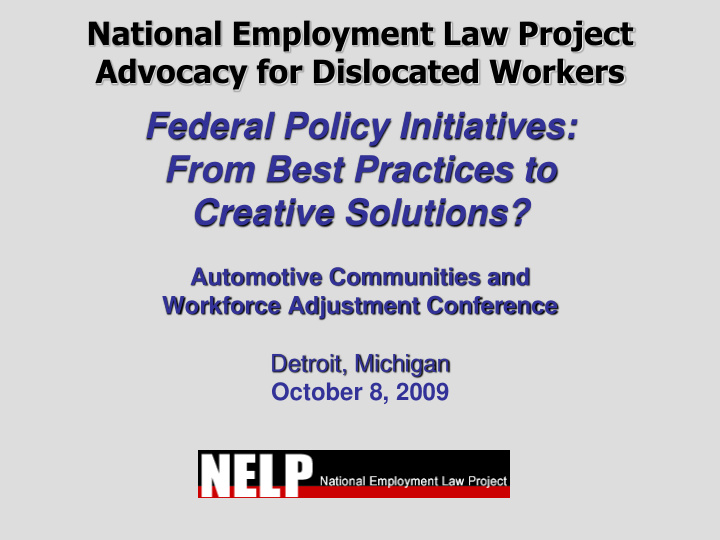



National Employment Law Project Advocacy for Dislocated Workers Federal Policy Initiatives: From Best Practices to Creative Solutions? Automotive Communities and Workforce Adjustment Conference Detroit, Michigan October 8, 2009
Overview of Topics • Federal Role/Responsibilities • Rapid Response/Dislocated Worker (DW) Best Practices • Added Elements of Better DW Programs and Manufacturing Policy • Emerging Workforce Challenges
Economic Adjustment Initiative • Funded by Mott Foundation (Flint) and Joyce Foundation (Chicago) to assist workers displaced from Midwest manufacturing jobs starting in 2006 • Focused on using effective dislocated worker practices, esp. in IL, IN, MI, and OH • Goals: increasing participation in these programs and gaining more funding and expanded eligibility for dislocated workers
Redefining Federal Role in Workforce Development • Provide Adequate Funding of DW Programs • Promote Best Practices and Require Them Where Authorized (example Rapid Response) • Proactive Role vs. Reactive Role – Monitor Dislocations in Real Time – Assist State and Local Program Providers When Needed • Pilot Programs/Funding for New Initiatives • Research/Evaluation
Dislocated Worker Program Best Practices • Identify Best Practices Based Upon History, Experience and Stakeholder Input • Core Best Practices Promoted by NELP: – Rapid Response/Advance Notice of Layoff – Peer Networks – Labor Management or Worksite Committees – Training Linked with TAA or UI – Labor Program Operators
Key Practice No. 1: State Rapid Response • Purpose: to provide information on services and programs, plan reaction to layoffs or plant closing, and ensure coordinated response to dislocation • More than an event — a process • Rapid response − Should be state function funded by state portion of federal WIA funds with local participants
Key Practice No. 2: Labor Management or Workplace Adjustment Committees • Voluntary worksite committee to develop and implement a strategy for assessing the employment and training needs of dislocated workers and obtaining services to meet such needs • LMC funding is authorized under WIA. • Direct funding and/or in-kind services from companies and/or unions (lost time) is also possible for LMCs. • Best way to communicate and work together at workplace level for better outcomes.
Key Practice No. 3: Peer Networks • Peers are individuals selected from the ranks of laid off workers that are trained to assist co- workers. • Peers: – Help develop trust in the dislocated worker program – Help workers overcome resistance – Help workers deal with denial, anger, fear, stress, and other barriers – Provide referrals and support for co-workers • Upon request, NELP assists with technical advice and backup
Key Practice No. 4: Income Support for Trainees thru TAA or UI • NELP promotes TAA as best existing dislocated worker program • TAA provides income support AND training for dislocated workers • TAA includes limited health care option • In addition to TAA, states can use better linkages between UI and training – Approved Training −Longer Benefits
Key Practice No. 5: Labor Program Operators • LPOs are labor-run non-profits that usually use federal WIA funds to provide services to dislocated workers. • IL, MI and OH have LPOs. Existing IN LPO was defunded by Governor Daniels. . • NELP supports LPOs broadly and we provide backup and support upon request in establishing them or helping them.
Beyond the Basics: Recommended Workforce Policies • Layoff Aversion/Early Warning – Community Networks/Data Mining – Linked with Business Retention/Assistance – Model is Pennsylvania • WARN Improvements – Longer Periods of Notice – Worker ID to State DW Unit – FOREWARN Act • Community-wide Adjustment/Participation – Navistar −Belvidere
Beyond the Basics: Recommended Workforce Policies — Part II • UI in Training – Available in 12 States (only IL in region) – Administration Pell Grant Initiative • Short Time Compensation/Work Sharing – Available in 18 States • Piggyback DW/Training Taxes – Available in 24 States (only MN in region) – Supplement WIA funding, incumbent and OJT
Emergency Policies Responding To This Recession • Wage Subsidies – MEED – For Long Term Jobless • Public Service Employment – Assist Impacted Localities – Rebuild Communities and Infrastructure • Short Time Compensation/Work Sharing – Community-wide Adjustment/Participation • Revolving Loans/Alternate Sources of Capitol/Employee Ownership
Emerging Workforce Challenges • Many Dislocated Workers with College Degrees and Skills —Don’t Fit the DW Mold —Don’t Need Training or Less Need for Training • Record Long Term Unemployment and Exhaustions of UI, including many older workers • Many training providers at or over capacity in IN, OH, and MI
NELP EAI Contacts • Rick McHugh, Midwest Coordinator/Staff Attorney, 734.369.5616; rmchugh@nelp.org • Lynn Minick, Workforce Development Specialist, 317.838.9220; lminick@nelp.org • Lindsay Webb, TAA Coordinator, 734.369.5615; lwebb@nelp.org • Lorene Randall, Dislocated Worker Facilitator, 810.762.5832; lrandall@nelp.org
Recommend
More recommend